Microwave weapons: four Leonidas systems have already been transferred to the US Armed Forces, deployment on US Navy ships from 2026
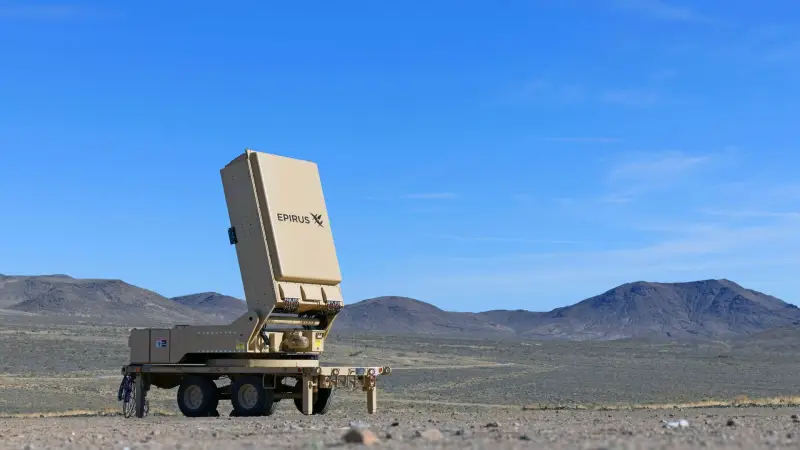
Image by Epirus
The end of the first quarter of the 21st century clearly showed that torpedoes and anti-ship missiles (ASMs) are far from the only threats to surface ships; unmanned aerial vehicles (UAVs) and unmanned boats (USB) - kamikazes - were added to them. Relatively low-speed, with a light, fragile design, often having a small warhead, but cheap, capable of being produced in huge quantities, often inconspicuous in the infrared (IR) and radar (RL) wavelength ranges.
Accordingly, at least two problems arose regarding the self-defense of surface ships from kamikaze UAVs and kamikaze BECs.
The first is that the cost of a self-defense weapon may exceed the cost of an attack weapon, for example, when an anti-aircraft guided missile (SAM) costing (relatively) a million US dollars shoots down a kamikaze UAV costing fifty thousand dollars.
The second problem is the limited amount of ammunition, for example, there are only a few dozen of the same missiles on board a ship, while there may be an order of magnitude more cheap kamikaze UAVs attacking it.
The same applies to ground forces - air defense systems simply do not have enough time or ammunition to repel an attack caused by swarms of UAVs, of course, if the interception zone is not stretched over thousands of kilometers, as was the case with the attack Iran on Israel, and the armed forces of more than three countries do not simultaneously take part in the interception.
The destruction of kamikaze UAVs and BEC kamikazes with “cheap” weapons, for example, such as small-caliber rapid-fire automatic cannons and machine guns, is possible up to a certain limit, since their range of use is limited, and at the final stage of movement of the kamikaze UAVs and BEC kamikazes they are simply they will not have time to shoot all approaching targets.
Perhaps, in this regard, Iran is “ahead of the rest”, with its ships “studded” with remotely controlled weapon modules (RCWM) - Iran is largely behind the concept of mass construction and use of kamikaze UAVs, it is not surprising that they have prepared for "symmetrical response".
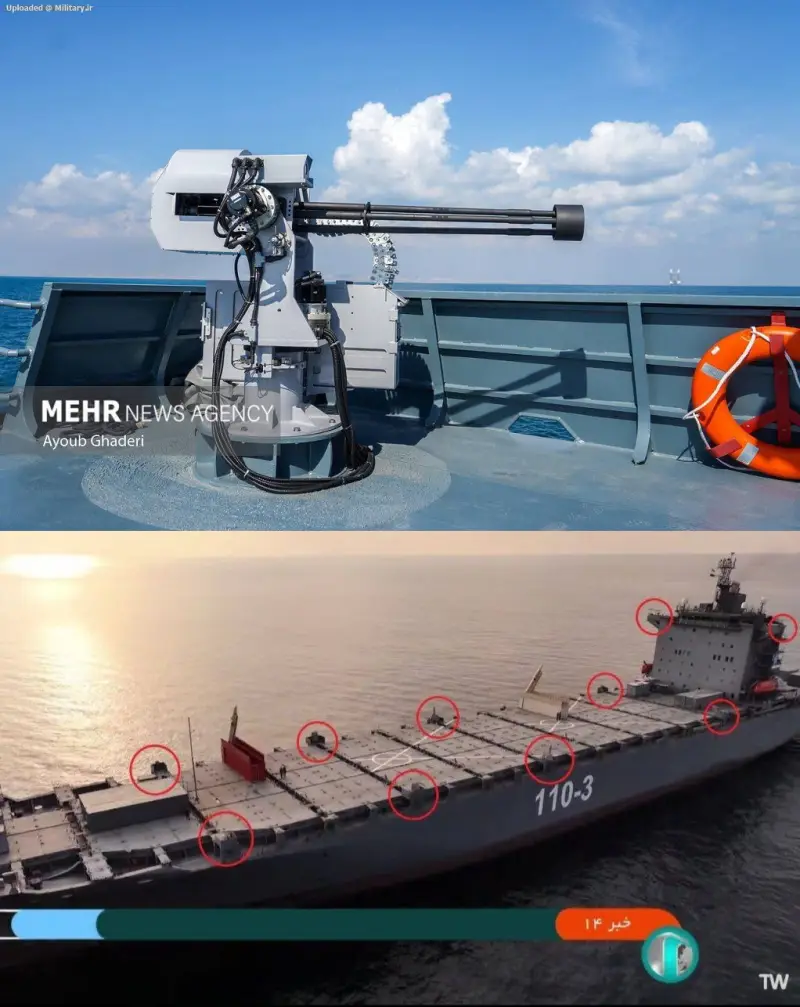
The Iranian ship is literally “strewn” with rapid-firing DUMVs. Image from TG channel “Belarusian Silovik”
In turn, the United States and its allies are moving towards creating weapons on new physical principles, in particular, the creation of directed energy weapons. Usually this refers to laser weapons - and indeed, the development of ground, ship and aviation Many countries and companies are developing combat lasers.
Just recently we talked about laser weapons have already begun to be tested in real combat conditionsIn addition, the British publication The Telegraph, citing a recent statement by the head of the British Defense Department, Grant Shapps, reported that there is a possibility of sending the DragonFire combat laser system to Ukraine, designed to arm ships of the Royal Navy. fleet and currently undergoing testing (By the way, The author also considered the possibility of supplying Ukraine with laser weapons, but it was assumed that these would be American DE M-SHORAD systems , but they turned out to be in demand in the Middle East, however, their appearance cannot be ruled out either).
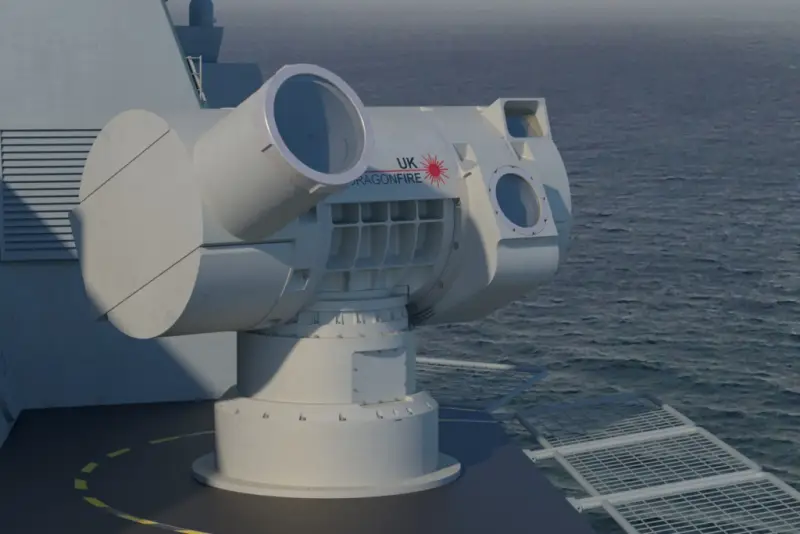
Shipborne combat laser system DragonFire. Image by MBDA
However, the concept of “directed energy weapons” is not limited to lasers alone; there is another direction - microwave weapons, which we will talk about today.
Microwave weapon
Microwave weapons are somewhat similar to laser weapons, but differ from them in many ways.
Like laser weapons, microwave weapons do not have physical ammunition, the target is hit by electromagnetic radiation, however, if a laser weapon is coherent monochrome radiation of the optical (most often infrared) region of the spectrum, then a microwave weapon is electromagnetic radiation, most likely millimeter or submillimeter wavelength range - the encyclopedia of the Ministry of Defense of the Russian Federation indicates the range of microwave weapons 0,3–300 GHz.
Microwave weapons cannot be focused as accurately or on such a small area as laser radiation, so they will hit a certain area anyway. The destructive effect of microwave weapons is not based on the destruction of the target’s body or any of its working surfaces, for example, rudders or engine/propulsion, but on the disabling of the target’s electronic filling.
Thus, there is no point in “shooting” microwave weapons at unguided projectiles (unlike laser weapons, starting from a certain radiation power, presumably from 50 kW).
At the same time, targets such as UAVs with bodies made of plastic or composites can be very vulnerable to microwave weapons because their “delicate” electronics, often made from commercially available components, are not able to withstand exposure to microwave radiation.
In its simplest form, a microwave weapon can be an emitter of electromagnetic radiation - a magnetron of the required frequency and power, as well as a parabolic antenna for focusing electromagnetic radiation. The “firing” range of tactical microwave weapons will most likely be limited to a few kilometers due to the fact that focusing millimeter-wave electromagnetic radiation over a long range will require very large structures, although some sources indicate a range of about five kilometers.
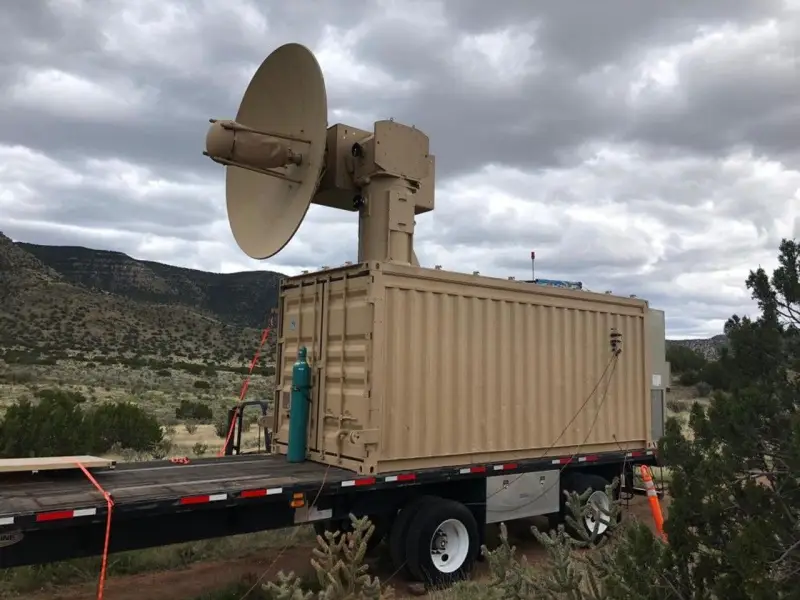
Prototype microwave weapon THOR. Image, US Air Force
At the same time, the use of parabolic devices for focusing microwave radiation requires high-speed guidance drives to track such “nimble” targets as small-sized UAVs or UAVs, therefore, apparently, the development of microwave weapons is shifting towards products with a phased array antenna.
It was this path that Epirus, the creator of the Leonidas microwave weapon, took.
Epirus Leonidas
The Epirus company was founded in 2018 in the USA, in Los Angeles, California, with the goal of developing and promoting anti-drone weapons, and already in 2020 the Leonidas microwave weapon system, made on solid-state gallium nitride elements, with electronic guidance, was introduced beam. Essentially, the Leonidas system uses radar technology with an active phased array antenna (AFAR).
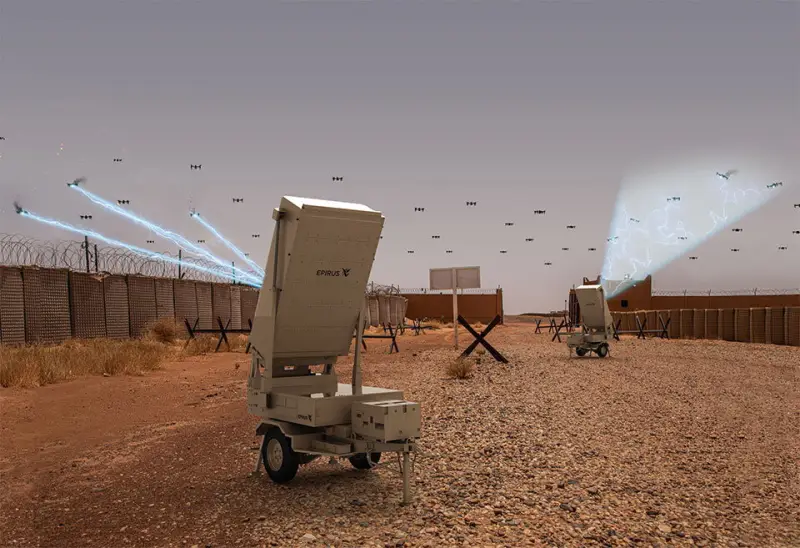
Leonidas microwave weapon complex
During testing in 2021, the Leonidas microwave weapon system shot down all 66 of 66 launched drones-targets, and in 2022 the third, improved iteration of the system was presented. According to Andrew Lowry, CEO of Epirus, their plant can produce three or four Leonidas systems per month.
Andrew Lowry also said that his company is negotiating the possible supply of Leonidas microwave weapon systems to Ukraine to counter Russian kamikaze UAVs of the Geranium-2 type; it is possible that the Stryker complex, developed jointly by Epirus and General Dynamics Land Systems, will be sent to Ukraine Leonidas.
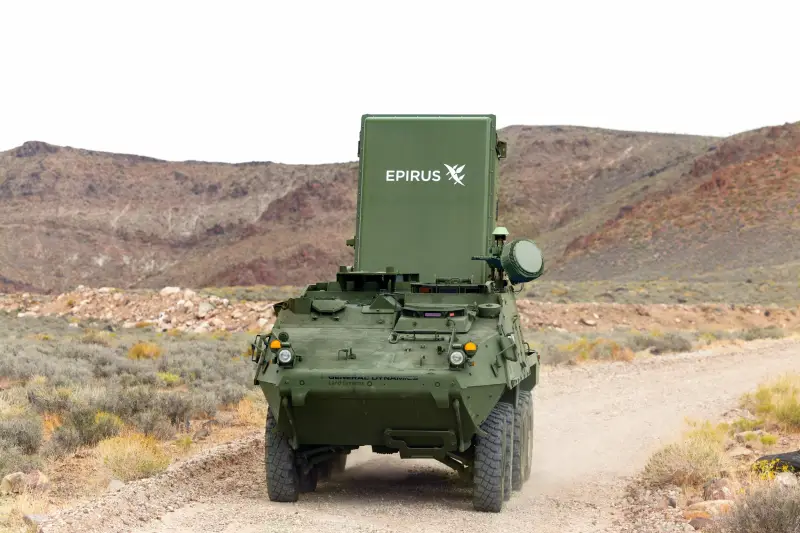
Stryker Leonidas complex
The US Navy is also developing microwave weapons. Under different names, the microwave weapons program has been going on since 1997; currently the program is called METEOR HPM (high-powered microwave - high-power microwave radiation) - previously the microwave weapons program for the US Navy was called REDCAT.
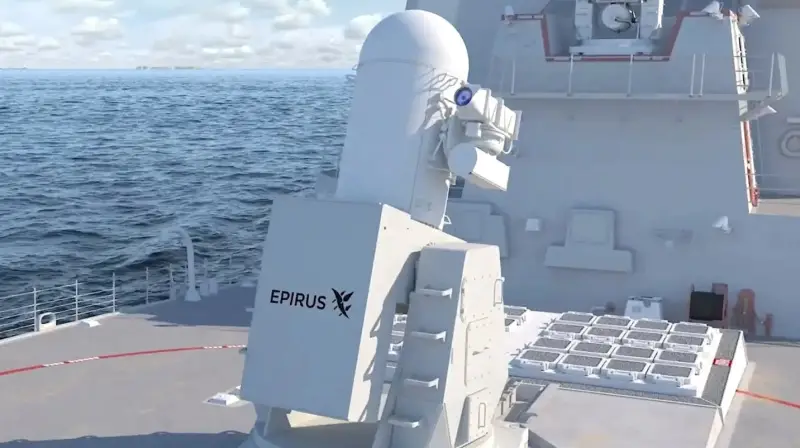
Shipborne microwave weapon system. Image by Epirus
According to open sources, Yemeni Houthi attacks on US Navy ships in the Gulf of Aden and the Red Sea, carried out with the help of kamikaze UAVs and BEC kamikazes, contributed to increased interest in programs for the creation and deployment of directed energy weapons. This indirectly suggests that the United States understands that their ability to repel Houthi attacks is based on the overwhelming superiority in the number of ships, planes and helicopters; in the event of an attack carried out by a more serious enemy, it will be extremely problematic to repel the blow of several hundred drones attacking simultaneously .
According to the US Navy's open budget for 2025, deployment of the first prototype microwave weapon under the METEOR HPM program is planned for 2026.
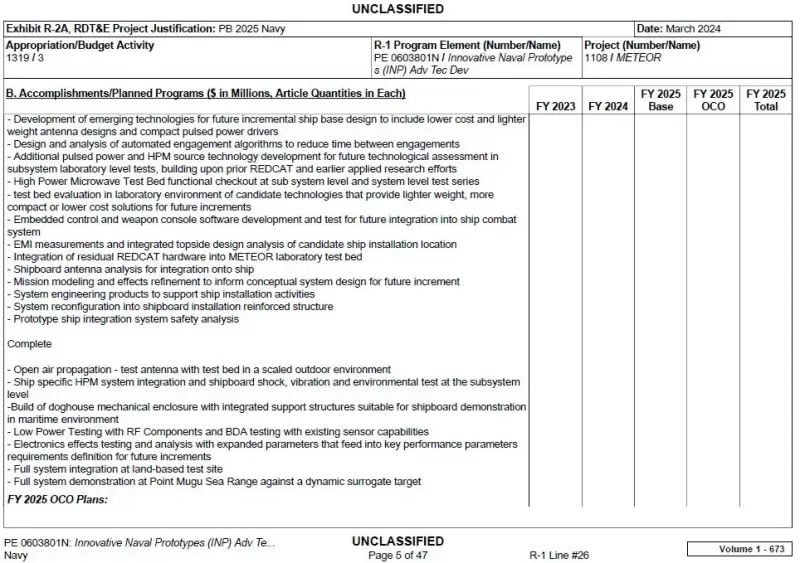
One of the sections of the US Navy budget for fiscal year 2025 relating to the METEOR HPM program
What capabilities will microwave weapons provide to US ground forces and ships?
Threats and restrictions
For what purposes are microwave weapons a threat?
First of all, these are small-sized UAVs made on the basis of commercial technologies, for example, FPV drones, which have become almost the main weapon on the line of combat contact (LBC) in Ukraine. Most likely, more serious products are also susceptible to the effects of microwave weapons, for example, kamikaze UAVs of the Lancet family.
It is unlikely that UAV-bombers of the Baba Yaga type will be able to operate within the range of microwave weapons - their operating altitude is about half a kilometer, and, most likely, they will be within the reach of microwave radiation.
As for such drones, for example, as long-range kamikaze UAVs like “Geranium-2”, then everything is no longer so clear. It can be assumed, that When flying a kamikaze UAV of the Geran-2 type at a maximum altitude of about 4–5 kilometers, microwave weapons located along the flight route may not be able to hit the target. At the same time, if the descent before striking the target is carried out by diving, then a kamikaze UAV devoid of electronic filling can still hit the target, at least this is what operators of FPV drones do now, who dive on the target if it is protected means of electronic warfare (EW).
If the route of a kamikaze UAV of the Geranium-2 type is laid at low altitude, then the chances of successful use of microwave weapons increase significantly.
It can be assumed that microwave weapons will have limited impact on high-velocity, low-flying munitions such as cruise missiles (CMs). Most likely, everything will depend on the range and terrain over which the missile launcher will fly, as well as where the microwave weapon will be located; in some cases it will be possible to ensure the defeat of the missile launcher, in others it will not.
As for ammunition flying along a high altitude, including a ballistic trajectory, they are unlikely to be affected by microwave weapons, as well as unguided ammunition of all types, as we have already discussed earlier.
Ways to protect
There are potential ways to protect against microwave weapons, even for FPV drones, but not all of them are worth discussing openly.
But, for example, for a long-range kamikaze UAV of the “Geran-2” type, a metallized coating can be created that completely eliminates the penetration of microwave radiation through the skin; only a small space in the upper part of the body, necessary for the operation of the GLONASS signal receiver, will remain open.
Very often on the Internet they say that you can protect yourself from laser weapons by covering the protected object with silver or foil, we talked about why this is impossible earlier in the material Resist the Light: Protection from Laser Weapons.
However, microwave weapons are unlikely to provide such strong and rapid heating of the target as to completely destroy and evaporate the metallized coating, at least at a distance of several hundred meters or more. Therefore, a conventional kamikaze UAV of the “Geran-2” type with a metalized body coating will most likely overcome the range of microwave weapons and hit the target, but one must understand that on radar screens such a UAV will be visible much better than a regular, unprotected kamikaze UAV type "Geranium-2".
Perhaps there are other solutions, both design and circuitry, that allow protection against microwave weapons.
Conclusions
Microwave weapons, like laser weapons, are rapidly moving towards entering service with the US Army and Navy, and possibly other countries as well - this is a factor that must be taken into account now when developing promising and modernizing existing weapons - SVO has become the strongest catalyst for the search and introduction of new methods of armed struggle.
As for the “symmetrical response,” in terms of Russian microwave weapons, information only comes up about the 15M107 “Foliage” remote demining vehicle (MDR), adopted to supply the Russian Strategic Missile Forces (Strategic Missile Forces), which solves its own specific tasks.

MDR 15M107 “Foliage”. Image by Mil.ru / Wikimedia Commons – Nickel nitride
Let's hope that in the depths of the Russian military-industrial complex (DIC) both symmetrical and asymmetrical responses to the challenges of our time are maturing, including the possible use of microwave weapons by the enemy.
Information